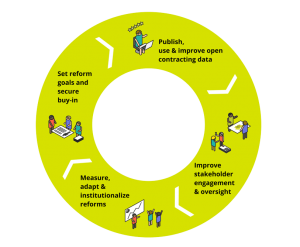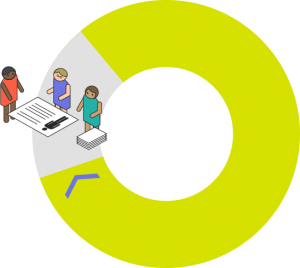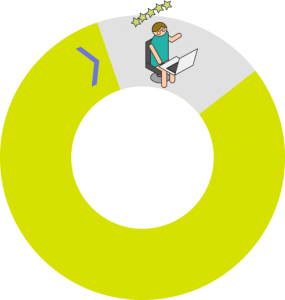Open contracting is a journey rather than a single destination. We’re here to help you get further, faster.
How to implement open contracting
Public contracting is the critical point where government budgets turn into vital goods, works and services for citizens. It is on the brink of a major transformation as it moves from paper to data and from being a compliance-based chore to being a digital service designed around users. We help drive that change.
Browse our practical tools, resources and guidance on implementing open contracting to get better reforms that stick. Learn how you can make your data user-friendly with tools such as the Open Contracting Data Standard. And find out more about our services and how our specialist teams can help you.

Implementing open contracting reforms
These are the common stages that we have seen from reforms that get to real impact and systemic change. We’ve divided our guidance into these four key elements of open contracting to help you identify the best resources at each step.
Set clear goals and secure buy-in
 At the heart of open contracting is driving better results from procurement and from public contracts, improving the efficiency, effectiveness and integrity of public contracting but also other policy priorities such as improving sustainability and/or inclusion. The whole contracting process should be simple, accessible and inclusive, designed with users across government, businesses, and civil society to maximize participation and efficiency.
At the heart of open contracting is driving better results from procurement and from public contracts, improving the efficiency, effectiveness and integrity of public contracting but also other policy priorities such as improving sustainability and/or inclusion. The whole contracting process should be simple, accessible and inclusive, designed with users across government, businesses, and civil society to maximize participation and efficiency.
Yet, despite the huge amounts of money at stake, entire procurement systems are designed without clear performance goals. ‘Open-by-design’ digitization of procurement offers an opportunity to consider not only the end-to-end management of the procurement system, but also how that system supports the wider public financial management and effectiveness of government.
The following resources help in co-designing procurement reform goals with stakeholders, such as user research, co-creation workshops, or market research to build a broader base of support.
Key resources
15 practical strategies for open, fairer, and better public procurement
Our guide From idea to impact: open contracting reform design and management provides you with the resources you need to implement procurement reforms.
The Open Contracting Legislative Guide takes best practice public procurement legislation across 8 countries to provide recommendations for designing best-in-class rules and guidance.
This resource demystifies a Theory of Change from the perspective of procurement reform. It includes resources and tips to help you create your own and get the most out of it.
This resources details a list of common indicators for an initial diagnosis of the performance of a procurement market using public procurement data
Publish, use and improve data
 Data and documents are often scattered across different systems and institutions so it is vital to bring information together so users can search and filter for the insights they need.
Data and documents are often scattered across different systems and institutions so it is vital to bring information together so users can search and filter for the insights they need.
Think about what information you and other stakeholders need to know, survey what information exists and where, and then make a plan to collect and share the information you need to attain your goals. If the information doesn’t exist, you need to make a plan to improve the completeness, structure, quality and timeliness of information until it does help you measure the things that matter. But publishing data and information alone are not an end. Only by working in collaboration with other government stakeholders, companies and civil society, you will make sure the data is used and can lead to results.
The Open Contracting Data Standard provides a unique global schema to bring together the data you need for your reforms. We have developed a large set of tools and resources that will help you in the process of publishing high-quality data that you can find here.
The resources below will guide your data strategy to publish, use and improve your data.
Key resources
How to determine the most valuable data and use them to make procurement better and fairer
The documentation brings together all of our guidance on the Open Contracting Data Standard
Functional requirements and template clauses that you can adapt for your technical specifications or procurement documents
What data should I collect? A guide to prioritizing data fields in an e-GP implementation
Including templates for data mapping, implementation case studies, and more
Our guide on best practices for developing open contracting data portals, with examples of great portals from around the world.
Access Open Contracting Data Standard data from more than 50 publishers.
Improve stakeholder engagement and oversight
 Long-term, durable public contracting reforms need to be inclusive and responsive, building on the endorsement of users, policy makers and politicians.
Long-term, durable public contracting reforms need to be inclusive and responsive, building on the endorsement of users, policy makers and politicians.
Feedback by buyers and sellers on each other improves their interactions and the performance of the procurement process. Feedback from citizens and users of services helps identify priorities, improves service delivery and builds public trust.
Consultation and monitoring are important opportunities for business and civil society to help shape better spending and foster innovation, particularly during the project planning and contract implementation stages.
The following resources pull together concepts and approaches to guide your stakeholder engagement strategy.
Key resources
This series of blog posts brings together case studies and examples for citizen procurement monitoring.
This publication collects strategies for government and the business ecosystem to increase engagement and opportunities.
This publication by the Chicago Council provides a summary of best practice citizen engagement and engaging with the supplier ecosystem as part of a strategic vision for procurement.
Six strategies for stakeholder engagement, improved monitoring, and oversight
This example from Mexico City shares how the city engaged with vendors, including by sharing data via a dedicated website, openly sharing vendor questions and answers, and issuing a request for information (RFI).
The example of how revolutionaries built a network of citizen corruption fighters in Ukraine
Measure, adapt and institutionalize reforms
 Change is hard. It takes time and care for new processes and regulations to stick and a new culture of openness and trust to build.
Change is hard. It takes time and care for new processes and regulations to stick and a new culture of openness and trust to build.
Implementing open contracting needs to be agile – responding and adapting to changing needs and demands. Once stakeholders are bought in, incentives change and coalitions for reform can be built that can overcome vested interests and help embed better ways of working and better results.
That’s open contracting!
The following resources provide you with the guidance to effectively measure your goals and progress, and with legal guidance to ensure your reforms stick.
Key resources
Our guide includes detailed resources to help you implement M&E and institutionalize reforms.
Get a backroom view on the people who make open contracting reforms happen and how open contracting data and approaches are driving reforms.
Governments will have to buy fundamentally different to address sustainability. This toolkit helps you plan, implement and measure open and sustainable public procurement.
The Open Contracting Legislative Guide takes best practice public procurement legislation across 8 countries to provide recommendations for designing best-in-class rules and guidance.
Some examples of how reform teams were able to adapt in the context of the COVID-19 emergency
Don’t hesitate to reach out to us to see how we can help you.
Questions? Ideas? Email us at engage@open-contracting.org or contact one of our experts.
For any technical questions, our Data Support Team is always available at data@open-contracting.org